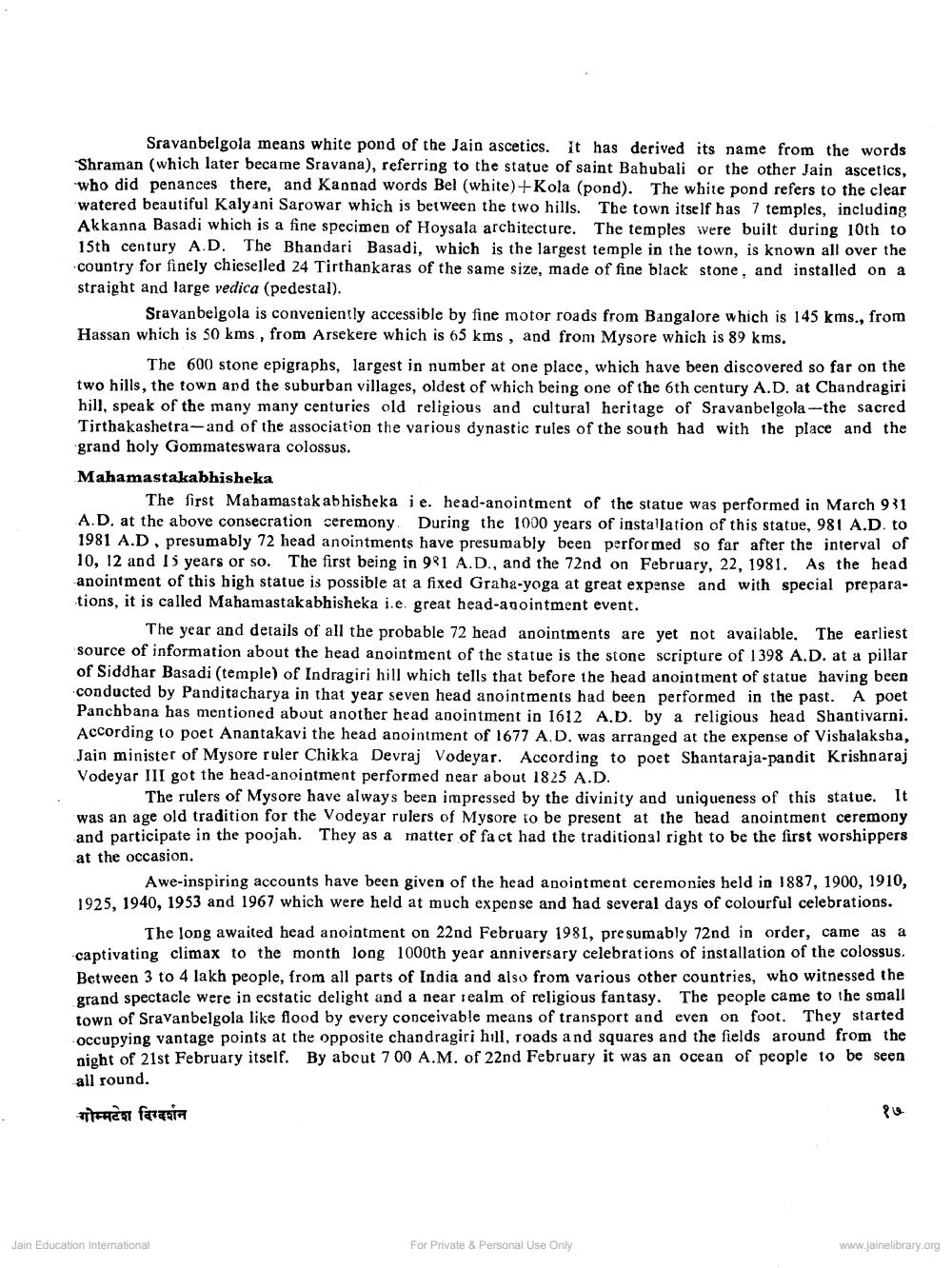Book Title: Gommateswara Mahamastakabhishek Author(s): Satishkumar Jain Publisher: Z_Deshbhushanji_Maharaj_Abhinandan_Granth_012045.pdf View full book textPage 4
________________ Sravanbelgola means white pond of the Jain ascetics. It has derived its name from the words Shraman (which later became Sravana), referring to the statue of saint Bahubali or the other Jain ascetics, who did penances there, and Kannad words Bel (white)+Kola (pond). The white pond refers to the clear watered beautiful Kalyani Sarowar which is between the two hills. The town itself has 7 temples, including Akkanna Basadi which is a fine specimen of Hoysala architecture. The temples were built during 10th to 15th century AD. The Bhandari Basadi, which is the largest temple in the town, is known all over the country for finely chieselled 24 Tirthankaras of the same size, made of fine black stone, and installed on a straight and large vedica (pedestal). Sravanbelgola is conveniently accessible by fine motor roads from Bangalore which is 145 kms., from Hassan which is 50 kms, from Arsekere which is 65 kms, and from Mysore which is 89 kms. The 600 stone epigraphs, largest in number at one place, which have been discovered so far on the two hills, the town and the suburban villages, oldest of which being one of the 6th century A.D. at Chandragiri hil), speak of the many many centuries old religious and cultural heritage of Sravanbelgola -the sacred Tirthakashetra-and of the association the various dynastic rules of the south had with the place and the grand holy Gommateswara colossus. Mahamastakabhisheka The first Mahamastak abhisheka i e. head-anointment of the statue was performed in March 931 A.D, at the above consecration ceremony. During the 1000 years of installation of this statue, 981 A.D. to 1981 A.D, presumably 72 head anointments have presumably been performed so far after the interval of 10, 12 and 15 years or so. The first being in 981 A.D., and the 72nd on February, 22, 1981. As the head anointment of this high statue is possible at a fixed Graha-yoga at great expense and with special preparations, it is called Mahamastakabhisheka i.e. great head-anointment event. The year and details of all the probable 72 head anointments are yet not available. The earliest source of information about the head anointment of the statue is the stone scripture of 1398 A.D. at a pillar of Siddhar Basadi (temple) of Indragiri hill which tells that before the head anointment of statue having been conducted by Panditacharya in that year seven head anointments had been performed in the past. A poet Panchbana has mentioned about another head anointment in 1612 A.D. by a religious head Shantivarni. According to poet Anantakavi the head anointment of 1677 A.D. was arranged at the expense of Vishalaksba, Jain minister of Mysore ruler Chikka Devraj Vodeyar. According to poet Shantaraja-pandit Krishnaraj Vodeyar III got the head-anointment performed near about 1825 A.D. The rulers of Mysore have always been impressed by the divinity and uniqueness of this statue. It was an age old tradition for the Vodeyar rulers of Mysore to be present at the head anointment ceremony and participate in the poojah. They as a matter of fact had the traditional right to be the first worshippers at the occasion. Awe-inspiring accounts have been given of the head anointment ceremonies held in 1887, 1900, 1910, 1925, 1940, 1953 and 1967 which were held at much expense and had several days of colourful celebrations. The long awaited head anointment on 22nd February 1981. presumably 72nd in order, came as a captivating climax to the month long 1000th year anniversary celebrations of installation of the colossus. Between 3 to 4 lakh people, from all parts of India and also from various other countries, who witnessed the grand spectacle were in ecstatic delight and a near realm of religious fantasy. The people came to the small town of Sravanbelgola like flood by every conceivable means of transport and even on foot. They started occupying vantage points at the opposite chandragiri hill, roads and squares and the fields around from the night of 21st February itself. By about 700 A.M. of 22nd February it was an ocean of people to be seen all round. गोम्मटेश दिग्दर्शन Jain Education International For Private & Personal Use Only www.jainelibrary.orgPage Navigation
1 2 3 4 5 6
